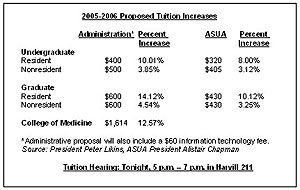
Tuition Increases
|
|
By Natasha Bhuyan
Arizona Daily Wildcat
Wednesday, March 2, 2005
Print this
Student leaders and administrators will square off once again when both present their tuition proposals to members of the Arizona Board of Regents at a hearing tonight.
The tuition hearing, at 5 p.m. tonight in the Harvill building Room 211, will be broadcasted at all three state universities and six branch campuses via videoconference, according to regent's reports.
Students, parents and the public will have the opportunity to share their thoughts about tuition.
"This the only time before the actual tuition ABOR meeting that students (can) voice their concerns about tuition and the regents are there willing listen," said Kim Bui, an Arizona Students Association director who helped draft the Associated Students of the University of Arizona tuition proposal.
"There's no reason not to go," Bui said.
Both President Peter Likins and ASUA President Alistair Chapman will present their proposals, which include increases in tuition along with fees, set-asides and financial aid.
Of the three state universities, the UA is facing the highest increase at 11.4 percent for undergraduate residents. Arizona State University President Michael Crow proposed an 8.5 percent increase for his undergraduate residents, while Northern Arizona University President John Haeger proposed a 7.8 percent increase, according to regents' reports.
Amy Williams, a pre-communication junior, said after the largest tuition increase in UA history two years ago of $1,010, or 39.1 percent, said she thought Likins' tuition hikes would end.
But in addition to a $400 increase in undergraduate resident tuition, Likins' plan includes a $60 mandatory information technology fee for all students, making his actual increase 11.4 percent. Likins recommended a $500 increase for nonresident undergraduate tuition and a $600 increase for residents.
Under Likins' proposal, UA South would not have a tuition increase.
Williams, an assistant manager at Anchor Blue at Tucson Mall, said she doesn't have the opportunity to join clubs at the UA because she has to work to pay for school, and a $400 increase means more hours of working.
In their tuition counterproposal, ASUA officials recommended a lower increase of $320, or 8 percent, for undergraduate residents. The student tuition proposal would set-aside a minimum of $30 per student for the class availability, which was identified as the No. 1 student concern in a tuition survey, Bui said.
However, Likins said while the ASUA proposal would provide $30 per student for course availability, his preliminary budget for next year grants new funding of more than $30 per student to the issue.
But Ryan Patterson, a veteran ASA director, argued Likins' budget is not a guarantee and the student proposal directly reflects student concerns.
"A regent in good faith cannot vote for an IT fee and not course availability," said Patterson, who is against the information technology fee along with ASUA officials.
Patterson said ASUA officials are garnering support from students, department heads and deans because their proposal addresses course availability, a major concern on campus.
Natalia Lopera, a journalism sophomore, said she works more than 20 hours a week, receives financial aid and still must take out loans to pay for college.
Lopera said although she is unsure how she would pay for another tuition increase, she would prefer to see the revenue be spent directly on her classes.
Anyone is welcome to attend tonight from 5-7 p.m. and students will be able to speak on a first-come, first-serve basis. The hearing will broadcast on Cox/Comcast Channel 76.
